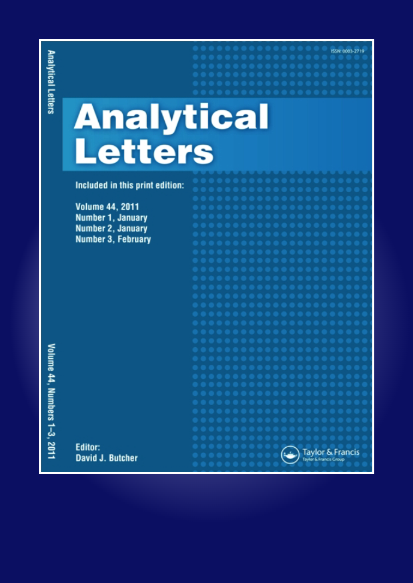血红素-锰(IV)氧化物标记酶联免疫吸附法测定免疫球蛋白G
IF 1.8
4区 化学
Q3 CHEMISTRY, ANALYTICAL
引用次数: 5
摘要
摘要以合成的血红素-MnO2纳米复合物为标记物,报道了一种用于人免疫球蛋白G的酶联免疫吸附试验(ELISA)。由于与单独的血红素和MnO2相比,血红素-MnO2纳米复合材料对3,3′,5,5′-四甲基联苯胺的催化活性增加,因此获得了增强的灵敏度。通过透射电子显微镜对合成的hemin–MnO2纳米复合材料进行了表征,并通过紫外-可见吸收光谱研究了其对3,3′,5,5′-四甲基联苯胺的催化活性。在板的96个孔中组装夹心型免疫测定后,基于血红素-MnO2的标记物催化3,3′,5,5′-四甲基联苯胺形成蓝色化合物,并通过板读数器进行监测。吸光度随人免疫球蛋白G浓度的增加而增加。该免疫测定法对人免疫球蛋白质G具有高灵敏度、长线性动态范围和良好的选择性。该免疫分析法也用于血清中人免疫球基因G的测定,结果良好。所开发的检测方法将ELISA的高通量和低成本与纳米复合标记的简单性相结合,适用于临床诊断。本文章由计算机程序翻译,如有差异,请以英文原文为准。
Determination of Immunoglobulin G by a Hemin–Manganese(IV) Oxide-Labeled Enzyme-linked Immunosorbent Assay
ABSTRACT An enzyme-linked immunosorbent assay (ELISA) is reported for human immunoglobulin G based on synthesized hemin–MnO2 nanocomposite as the label. Enhanced sensitivity was obtained due to the increased catalytic activity of the hemin–MnO2 nanocomposite toward 3,3′,5,5′-tetramethylbenzidine compared to hemin and MnO2 alone. The synthesized hemin–MnO2 nanocomposite was characterized by transmission electron microscopy and its catalytic activity to 3,3′,5,5′-tetramethylbenzidine was investigated by ultraviolet–visible absorption spectroscopy. After assembly of the sandwich-type immunoassay in the 96 wells of the plate the hemin–MnO2-based label catalyzed 3,3′,5,5′-tetramethylbenzidine into blue compounds that were monitored by a plate reader. The absorbance increased with the concentration of human immunoglobulin G. The immunoassay displayed high sensitivity, a long linear dynamic range, and good selectivity for human immunoglobulin G. The immunoassay was also used for the determination of human immunoglobulin G in serum with favorable results. The developed assay combines the high throughput and low cost of ELISA with the simplicity of nanocomposite labeling and is suitable for application in clinical diagnosis.
求助全文
通过发布文献求助,成功后即可免费获取论文全文。
去求助
来源期刊

Analytical Letters
化学-分析化学
CiteScore
4.10
自引率
5.00%
发文量
218
审稿时长
2.1 months
期刊介绍:
Analytical Letters is an international medium for the rapid publication of original research papers, accelerated articles, or mini-reviews on important developments in all areas of analytical chemistry, including electrochemistry, mass spectrometry, separations, and spectroscopy. Papers are welcomed that consider fundamental developments, new or improved instrumentation and sensors, and applications of analytical chemistry in all areas that include biological and clinical science, engineering and instrumentation science, environmental chemistry and analysis, geochemistry, materials science, nanotechnology, and physics.
 求助内容:
求助内容: 应助结果提醒方式:
应助结果提醒方式:


